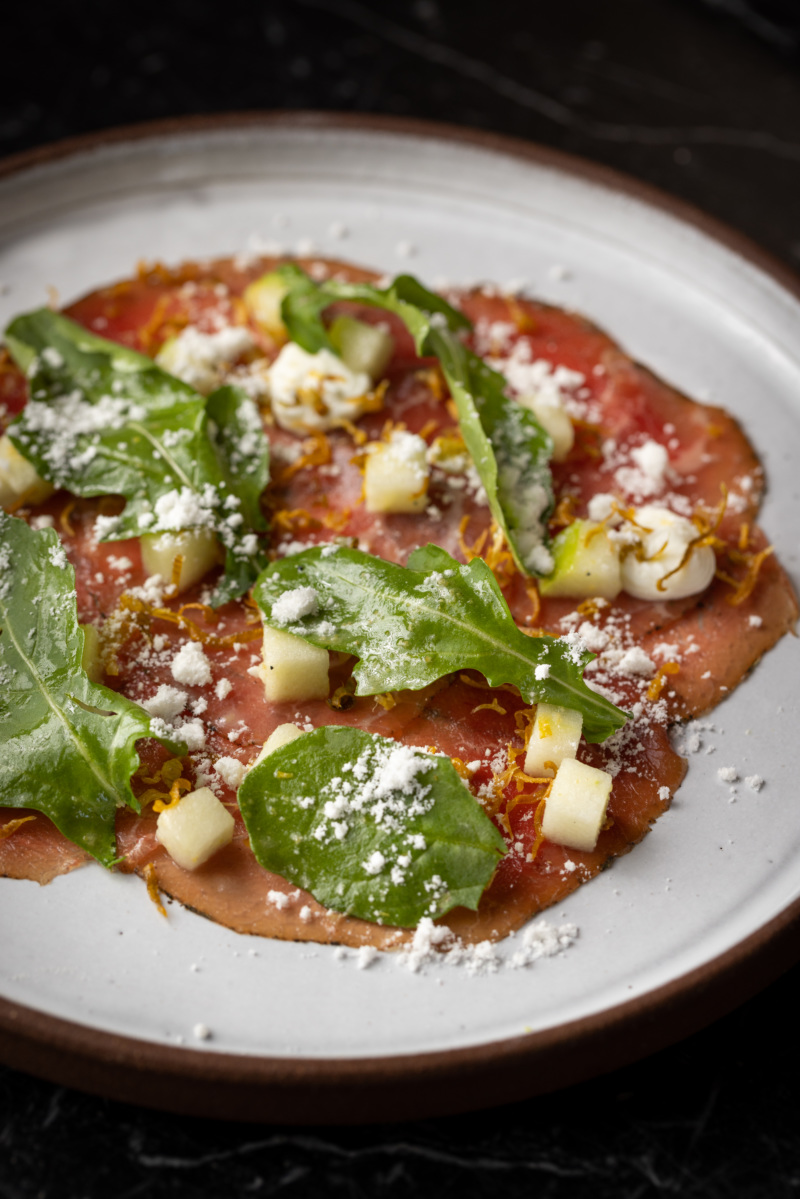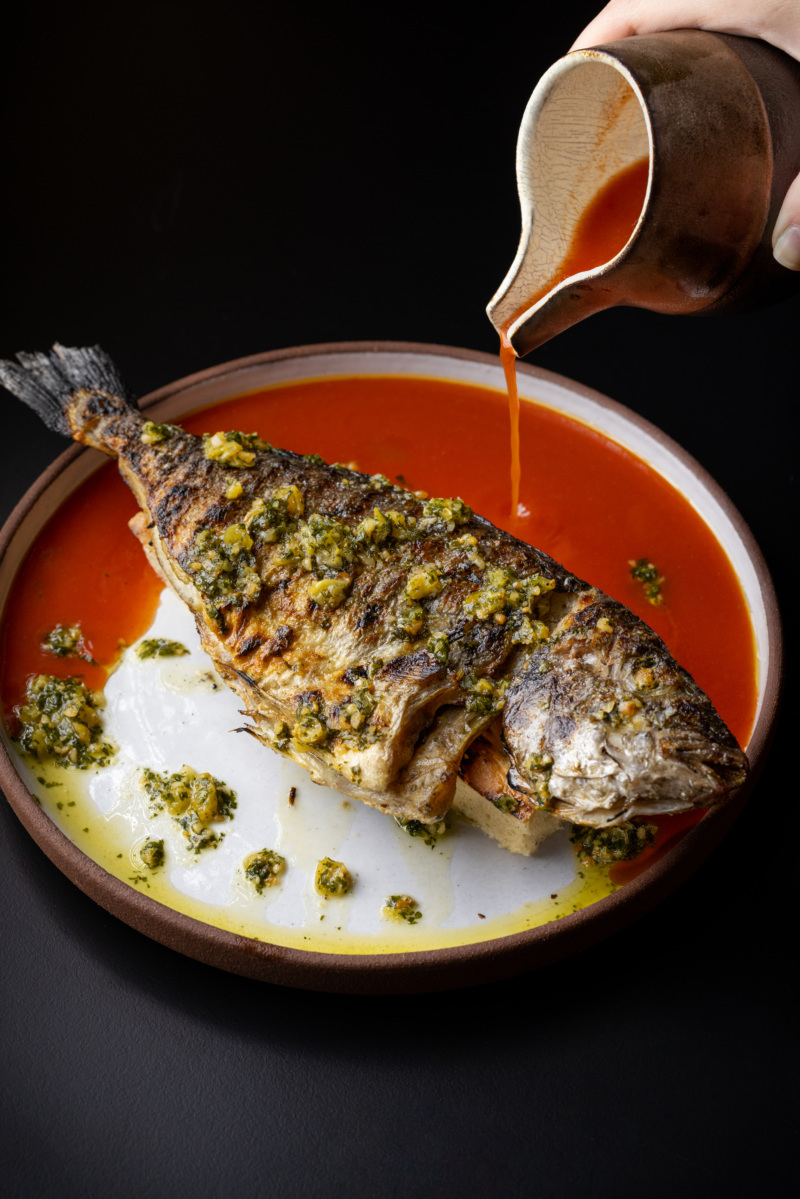
The Dishes You’ll Want to Order at Magari
In L.A.’s sea of Italian restaurants, there are a few ways to stand out: a regional focus, perhaps; perfecting a singular dish, or maybe a celebrity chef at the helm. In the case of Magari in Hollywood, what’s different is, well, a little different.
Magari incorporates Japanese technique and ingredients into traditional regional Italian dishes. While continents away, dishes from both countries have a lot in common, says executive chef Enrico Merendino, who was born and raised in Sicily and has cooked up and down the West Coast. Pristine local and seasonal ingredients are paramount, and Merendino says utilizing Japanese techniques only elevates his food.
“The through line between Japan, Italy, and L.A. is really the ingredients,” says the chef. “Southern California is similar to Sicily in its landscape, but also the produce. The citrus and tomatoes here are as good as my home. Putting Japanese touches here and there, it’s all for a reason — to enhance a dish, and make it better.”
Here, Merendino breaks down some of the restaurant’s most popular dishes, and how they tell the story of the restaurant and his own journey.


1. Akami tuna
“This is one of our crudos, an uncommon presentation that works really well. We only use bluefin tuna from Baja California. Spanish tuna is great, but by the time it gets here, it’s already a week old. It starts losing some quality. We break down all of our own fish, and get the lean part into a perfect square, like sushi, for a nice slice. We pair it with this burrata from Puglia — really nothing can compare to it. It has just enough sweetness and acidity, and the creaminess of the milk is consistent.
On top of the burrata we put caponata, which is cooked pepper, eggplant, raisins, and pine nuts, deglazed with balsamic vinegar and a touch of honey. It’s very traditional in Sicily. We use it as a side dish or with steaks. Because of the richness of the tuna and burrata, this adds a nice sweet element. We season the dish with really good olive oil and yuzu. I wanted a nice citrus element but not lemon; yuzu is perfect here. It’s all about the mouthfeel: the creaminess of the burrata, the tuna springs back when you eat it, the crisp element of pine nuts. We can’t keep up with orders for it.”


2. Wagyu carpaccio
“I always love making carpaccio. There are a lot of different ways to do it, and I’ve tried a lot in the past, but this one is pretty special. First, we use Miyazaki A5 wagyu, which is amazing beef. I use the eye of round, a pretty traditional cut in Italian cooking, especially for bresaola. So I prepare it the same way, curing it with dill, juniper, black pepper, salt, and lemon zest. But bresaola is usually cured for at least 30 days, here I only do it for a few days, just to firm it up.
When it’s ready, we slice it super-thin, and instead of traditional arugula, Parmesan, lemon juice, and extra-virgin olive oil, we make a vinaigrette with Japanese lime, sudachi, and a little bit of sansho pepper, which has a numbing effect. We dress the carpaccio with that, along with crispy fried artichokes and arugula. Instead of Parmesan cheese, we make a powder with bone marrow. It gives a little nuttiness and depth, and umami, like the cheese would. When you look at it, you’re like, yeah, that’s carpaccio. But in reality, it’s different than anything you’ve had before.”


3. Yuzu tagliatelle
“The idea behind this dish is that in Sorrento, there’s an abundance of lemons, so lemon pasta is common — usually just handmade pasta tossed with lemon zest and juice, cheese, and butter. So we put our spin on that. We start with a super-traditional tagliatelle that’s made with 50 egg yolks. For the sauce, we swapped in yuzu for the lemon, and added peekytoe crab, which is extremely sweet and really rounds out the yuzu. Top it with a little bit of chive, and that’s it. We offer uni as a supplement, which adds a nice oceanic element. Almost everyone gets it with uni.
Honestly, this is one of the reasons why I wanted to work here. I know my cooking, and I’ll push my boundaries a bit, but I don’t want to overcomplicate dishes. That’s what made me realize how good this would be. Both Italian and Japanese cuisine are streamlined, but you have to be meticulous each step of the way. This dish, for instance, has a pan sauce made in the moment. It takes a lot of training to make sure it’s always on point, with the right amount of butter, yuzu, and cheese, to make sure it doesn’t break. Achieving perfection every time is the hard part.”


4. Grilled whole orata
“Growing up in Sicily, I went fishing all the time, even after work at night. My main target was always orata, a beautiful fish in the bream family. Kind of between a branzino and snapper. Here we grill the whole fish, butterflied and deboned ahead of time. We serve it with salmoriglio, which is mainly parsley, lemon, garlic, but add a little raisin and pine nut. The Japanese element comes in with the acqua pazza, which means “crazy water” in Italian, or a broth used to poach or serve with fish. Basically it’s fish sauce, parsley, garlic, and anchovy, and only the liquid from straining San Marzano tomatoes. But we add bonito flakes to give it depth and umami.
We put the fish on two pieces of focaccia and pour the acqua pazza on the plate, so at the end, you’re left with this bread soaked in all the juices. In Italy, we use the word scarpetta, meaning clean the plate with bread. Here, the bread is already soaked and ready to be eaten.”


5. Cannoli
“We had to have cannoli, right? But there’s a big problem. Making it correctly is challenging, especially if you don’t have the right ricotta. So we get sheep’s milk ricotta from Italy. The filling is very traditional, just ricotta and powdered sugar. The tricky part is the shell. In Italy it’s made with lard, because olive oil used to be very expensive, but pig fat was abundant. Lard makes for a very flaky dough. You can substitute any other fat, but it will never get as flaky as it will with lard.
So we make ours the traditional way, but of course we needed to add another element to make it Magari. My pastry chef came up with this sudachi cream sauce that’s on the plate, along with yuzu gel and candied oranges and mango. When you eat it, it’s great cannoli, but with the cream and gel, it’s an explosion of different flavors. Being Sicilian, I’m a purist when it comes to my cannoli, but I really like this cannoli. It might be my favorite.”
Lesley Balla writes about restaurants, travel, wine, and more. You’ll find her work in publications including Los Angeles magazine, Angeleno, The Hollywood Reporter, and The Seattle Times. In a previous life she was the L.A. editor for Zagat and Eater. Follow her on Twitter and Instagram. Follow Resy, too.
























